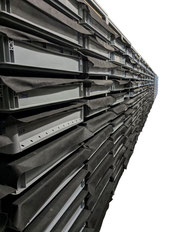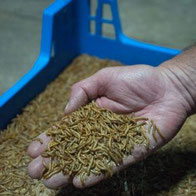Tray Systems for Space-optimized Insect Farming Facilities

Insect farming includes the rearing of insects for substances that the insects produce, or for the insects themselves for use as feed or food source. Adult insects are bred to produce eggs, which hatch into larvae. Food and water are provided to the larvae to facilitate growth and development. After some time, larvae metamorphose into pupae and then into adults. Before the larvae transform into pupae, a large portion of the larvae can be collected and processed. Some are allowed to mature to reproduce - ensuring the self-sustainability of the insect colony. Larvae skin and frass are often collected to be used as a raw material to produce organic fertilizer, etc.

Tenebrio molitor, commonly referred to as mealworm (in German "Mehlwurm"), for example, is best known for its larval form (see Figure). The mealworm itself is often used as living food for insectivorous pets, or as fishing bait. However, Tenebrio molitor is a prime natural source of proteins. The high concentration of proteins in Tenebrio molitor, its composition and a lipid profile that includes most of the essential fatty acids, make it a feed/food with interesting nutritional benefits and a low C footprint. There are a number of considerations for maximizing the efficiency of insect farming facilities. For instance, farming environmental conditions must be carefully taken into account: temperature, humidity, light, and ventilation. Pests must be contained.
Larvae and adult insects may be most efficiently housed within trays, stacked in space-optimized racks that are modular components in a larger facility. Given the manifold daily operations to be performed, it is key to maximize the (space and cost) efficiency of rearing systems - minimizing labour costs. We currently offer two compatible system for mealworm breeding:
- Mealworm tray and rack systems, allowing for easy maintenance of individual trays
- Stackable, stand-alone mealworm trays, providing a cost-effective solution for certain rearing stages and a save transport systems for living larvae
VSI Insect Farming Tray & Rack Systems

Tray & Rack Systems for Mealworm Production, space and labour efficient tray-based insect rearing systems for feed or food production, tested and optimised with mealworm farmers to meet the specific needs of your insect rearing facility. In particular, we manufacture cost-effective racks to hold standardized trays of your choice - building flexible, long-lasting and scalable rearing systems. We design racks to fit your facility, adjusting height, width and number of racks to make the most of your available space. We work with entomologists to advise on systems suitable for your target insects and the scale (scalability) of your insect farm. From previous projects, we have particular experience with rearing systems developed for mealworms.
Material Racks: Aluminium bars (5x5 cm; side poles) and angle aluminium bars (top and bottom, slides), stainless steel screws.
Various versions (see Types/Models below) to suit all tray sizes and the spatial configuration/workflow of the facility:
- Loads trays from one or two sides (front and back, standard)
- Side-by-side units with two or three adjacent racks in one unit (with shared centre poles)
- Fixed legs (standard), or on turnable wheels
- Optional: with mesh sides, bottom, top, & mesh front door (for potential isolation of infested trays); higher or lower racks; orientation of trays, ...
Trays: Standard, commercial trays depending on species (PP, grey; various dimensions).
The production trays used are standardized ("Euroboxes") and are purchased in bulk directly from the manufacturer to provide the most cost-effective tray and rack systems for insect production and to allow for easy facility expansion without changing the rearing tray type. Contact us to discuss your insect rearing objectives and how VSI's mealworm racks can support your goals!
Insect production RAcks - Features
- Cost-effective, making use of standard trays and a simple yet durable stainless racks
- Space optimized, a combination of various models maximizes floor use in given facilities
- Flexible access, easy and fast access to every single tray
- Future proof, modular design, allows for easy scaling and reconfiguration
| Specifications | Mealworm Racks | OPEN |
|
Standard Tray & Rack Systems for the Mass Production of Mealworms:
Single-sided Production Unit (front loading; perfect to be positioned with the back to a wall, suitable for starting your rearing facility):
Double-sided Production Unit (for loading trays from adjacent sides; perfect to be placed in rows in the centre of rearing rooms with walkways on both sides)
Side-by-side Units. Single- and double-sided units are available as one (as above), two or three adjacent rack units (in a row) at a reduced cost (by the reduced need for aluminium rack poles in the centre of side-by-side unit). See Table 1 below for details on the different combinations. Larger side-by-side rack units can be build on customer demand - fitting the rearing facility layout. Contact us directly for individual pricing for larger projects. |
||
| Types/Models | Mealworm Production Racks | OPEN | ||||||||||||||||||||||||||||
|
Table 1: Mealworm Production Rack Types. Units with single- or double-side loading of trays, number of adjacent racks (1, 2 or 3), and the total number of trays per mealworm production unit type.
|
||||||||||||||||||||||||||||||
Shipping & Assembly of Insect Production Racks

Insect Production Racks are shipped pre-assembled. The side/middle panels with slides are assembled, while the top and bottom bars can be easily installed by the customer - resulting in significantly reduced shipping costs. All parts are included for easy do-it-yourself installation. We are happy to get you started with the installation via video call; fully assembled or on-site installation service available upon request.
Stackable trays for insect breeding

Stackable rearing trays. The stackable trays are suitable for a variety of insects including mealworms and are ideal for use with automated systems, providing sufficient height and an open corner design to optimise ventilation, particularly during transport. Available tray sizes are 60 x 40 cm (W x L) with a height of 14.5 cm or 19 cm (H) and 80 x 60 x 19 cm (W x L x H). This stackable insect rearing tray design does not allow individual trays to be removed (unlike the production racks above), this has minor disadvantages at rearing stages where development between trays is not 100% homogeneous, potentially requiring different feet to be applied to different trays and/or hindering the collection of early emerging beetles to prevent cannibalism. However, at certain stages and during transport of live larvae to customers, the stackable trays are a viable solution to both reduce the cost of (rack) infrastructure and/or to prevent excessive temperatures developing in closely stacked Euro trays (as above). Based on our customers' experience, we therefore recommend that the cost-effective stackable trays are used in addition to tray and rack systems in a mixed operation.

Mealworm Trays - Features
- Food-grade PP, certificate from manufacturer
- Cost effective
- Enhanced ventilation, perforated corner design
- Robust and durable, 3-yrs manufacturer warranty
- Stackable, ideal for automation
- Smooth surface for easy cleaning
- Two sizes available (40 x 60 cm; 60 x 80 cm; both 19 cm high)
Optional
- Reduced high (14.5 cm; 40 x 60 cm only) for using your space most effectively (e.g. during transport etc.)
| Models | Mealworm Breeding Trays | OPEN | |||||||||||||||||||||
|
|
|||||||||||||||||||||||
Large Scale Mealworm Production

Mealworm rearing rooms are ideally maintained at a temperature of 25-30°C and a relative humidity (RH) of 50-75% (Manojlovie, 1988; Chen and Liu, 1992). Plastic trays are commonly used in European and North American farms.
The optimum density for rearing adults is approximately 0.94 larvae per cm2 (i.e. ~2200 larvae per 60 x 40 cm tray). Adults typically begin oviposition on the fourth day after emergence. Oviposition substrates, such as a wheat bran bedding contained within a mesh screen, are used to collect semi-synchronized eggs. During the 40-50 day spawning period, adults must be transferred to another container every 3–5 days to maintain semi-synchronized eggs. Larvae typically hatch approximately 7 days after egg deposition. For commercial larval production, the recommended rearing density is 1.18 larvae per square centimetre (Wu, 2009), i.e. ~2500 per 60 x 40 cm tray.

The medium used to raise mealworms, both larvae and adults, is a mixture of wheat bran and partially vegetables. For optimal mealworm nutrition, the water content of the wheat bran and vegetable feed should ideally be ~18% (Wu et al., 2009). Vegetables should be washed and air dried to remove potential pesticide residues, soil, etc. On a daily basis, one hundred larvae require approximately 6-10 g of wheat bran and 0.6-1.0 g of fresh vegetables (such as carrot, cabbage, pumpkin, etc.), which should be added separately at regular intervals (twice a day) and removed immediately if spoiled.
- However, despite the optimized nutrition/hydration provided by the addition of vegetables, many mass rearing facilities choose to add only agar agar (cubes, shreds) to the wheat bran to provide a consistent moisture source. This significantly reduces the daily maintenance process with little impact on production. Show more
-
The literature also recommends cleaning the rearing trays every 3-5 days to remove larval waste (frass). However, longer cycles (up to about 10 d) can be implemented, especially when no vegetables are fed and humidity is not too high (i.e., limited fungal growth), thus reducing the labor intensity of the rearing process. If longer cleaning cycles are used, it is important to keep an eye on pests such as moths and to take immediate action when detected - including hormone traps, release of natural antagonists, and special separation and/or removal of (potentially) infested trays.
Production from a tray is variable and depends on: larval density, harvest time, temperature, and diet. For example, high density larvae may produce more biomass in a tray for a given period of time, but will take longer to mature (due to stress and reduced resource availability). When using very high densities with climate control (heating), you can achieve between 1.3-1.6 kg per tray (60 x 40 cm). This is the upper end of the weight range for slower or reduced growth rates. High densities have faster growth rates (but require more space) and range from 1.1-1.2 kg. The goal in any facility is to achieve densities that provide a good balance between growth rates and space efficiency under the given rearing conditions. This requires some preliminary testing, and optimal densities may vary between seasons under all but fully climate-controlled rearing conditions.

Larval segregation and collection is primarily accomplished by the use of a 60 mesh screen, a process that has been partially automated in some facilities by the use of an electric vibrating screen (see image). Some degree of automation for larval collection and frass removal is key for the efficient operation of a medium (perhaps starting with a few hundred trays) to larger scale insect farm. Full automation of feed application, tray placement and removal, and sorting are hot topics for successfully scaling mealworm farms to mass production facilities.
| References |
Insect Farming for Food, Feed, Fertilizer and more |
OPEN |
|
||
Open for R&D: Automation of Mealworm FarmS
Mealworm rearing techniques, have improved significantly over the last years. However, semi- or fully automated mealworm rearing racks are still developing. Given the predicted increase in demand for insect protein and related products, we would gladly develop a joint R&D proposal to prototype and test (joint) automation ideas in close interaction with future users. We hold considerable experience in managing and executing R&D&I projects, We are particularly interested in increasing space and labour efficiency (automatic feed application, sieving, tray placement etc) of mealworm farming facilities. If you are interested, please contact us to discuss funding options / ideas.
To measure the Carbon footprint of your mealworms and to scale it up to your mealworm farm, consider the Insect Respirometry Package.
For the mass rearing of mosquito larvae/pupae in water-filled trays, consider our IAEA-approved Mosquito Tray & Rack System / Mosquito Trays.












